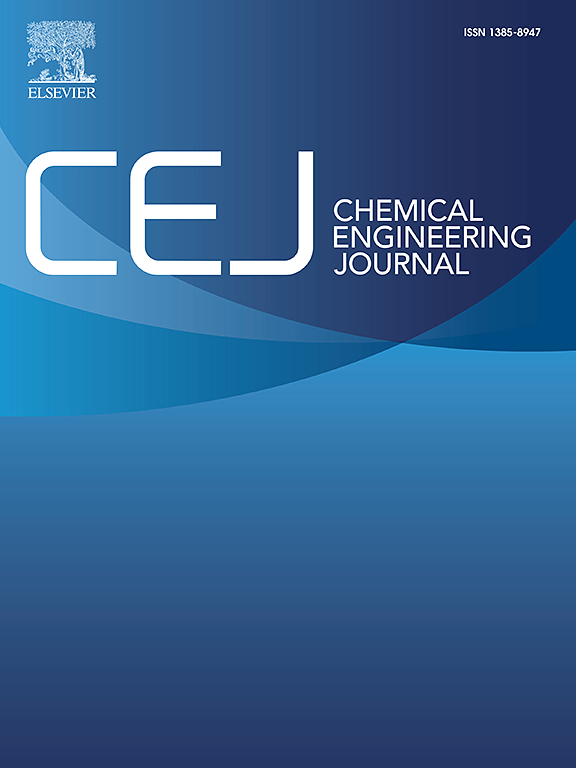Polyzwitterionic double-network hydrogel with high salt resistance and low evaporation enthalpy for efficient solar desalination and electricity generation
IF 13.2
1区 工程技术
Q1 ENGINEERING, CHEMICAL
引用次数: 0
Abstract
Solar-driven interfacial evaporation has emerged as a sustainable and promising technology for addressing the freshwater scarcity and energy resource limitations. Nevertheless, its practical implementation is still constrained by salt deposition, high evaporation enthalpy and intermittent solar illumination. Herein, a facile preparation method is used to prepare a polyzwitterionic double network hydrogel-based solar steam generator. The inherent anti-polyelectrolyte effect of zwitterionic groups makes the hydrogel form a more hydrated polymer network in high-concentration brine, improving the evaporation performance. The interpenetrating network structure formed from chitosan and polyacrylic acid improves the mechanical properties. The evaporator possesses a higher evaporation rate of 2.26 kg m−2 h−1 and the lower evaporation enthalpy of 1019 J g−1 in 10 wt% brine than that in pure water (evaporation rate: 2.08 kg m−2 h−1; evaporation enthalpy: 1128 J g−1). The evaporator keeps a stable evaporation rate after 7 evaporation cycles and shows a long-term durability in outdoor evaporation experiments. Furthermore, the hydrogel evaporator is employed for temperature difference power generation and thermoelectric evaporation, generating a high output power density (181.25 mW m−2 in wet state) under 1.0 sun and achieving an evaporation rate of 1.23 kg m−2 h−1 without solar illumination in 10 wt% brine. This study proposes a novel strategy to construct durable solar evaporators with high salt resistance and low evaporation enthalpy for efficient water production and electricity generation.

具有高耐盐性和低蒸发焓的多两性离子双网水凝胶,用于高效太阳能脱盐和发电
太阳能驱动的界面蒸发已经成为解决淡水短缺和能源限制的一种可持续和有前途的技术。然而,它的实际实施仍然受到盐沉积,高蒸发焓和间歇性太阳能照明的限制。本发明采用简便的制备方法,制备了一种多两性离子双网水凝胶基太阳能蒸汽发生器。两性离子基团固有的抗聚电解质作用使水凝胶在高浓度盐水中形成更加水合的聚合物网络,提高了蒸发性能。壳聚糖与聚丙烯酸形成互穿网络结构,提高了材料的力学性能。 蒸发器具有高蒸发率2.26公斤 m−2 h−1和1019年的较低的蒸发焓 J g−1 10 wt %盐水比纯水(蒸发率:2.08 公斤 m−2 h−1;蒸发焓:1128 J g−1)。蒸发器经过7次蒸发循环后保持稳定的蒸发速率,在室外蒸发实验中表现出长期的耐用性。此外,水凝胶蒸发器用于温差发电和热电蒸发,在1.0太阳下产生高输出功率密度(181.25 mW m−2湿态),在10 wt%的盐水中,无太阳光照的蒸发速率为1.23 kg m−2 h−1。本研究提出了一种新型的高耐盐性和低蒸发焓的太阳能蒸发器,以实现高效的制水发电。
本文章由计算机程序翻译,如有差异,请以英文原文为准。
求助全文
约1分钟内获得全文
求助全文
来源期刊

Chemical Engineering Journal
工程技术-工程:化工
CiteScore
21.70
自引率
9.30%
发文量
6781
审稿时长
2.4 months
期刊介绍:
The Chemical Engineering Journal is an international research journal that invites contributions of original and novel fundamental research. It aims to provide an international platform for presenting original fundamental research, interpretative reviews, and discussions on new developments in chemical engineering. The journal welcomes papers that describe novel theory and its practical application, as well as those that demonstrate the transfer of techniques from other disciplines. It also welcomes reports on carefully conducted experimental work that is soundly interpreted. The main focus of the journal is on original and rigorous research results that have broad significance. The Catalysis section within the Chemical Engineering Journal focuses specifically on Experimental and Theoretical studies in the fields of heterogeneous catalysis, molecular catalysis, and biocatalysis. These studies have industrial impact on various sectors such as chemicals, energy, materials, foods, healthcare, and environmental protection.
 求助内容:
求助内容: 应助结果提醒方式:
应助结果提醒方式:


